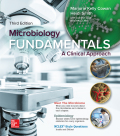
Concept explainers
Introduction:
A virus is a small infectious agent that cannot be seen through the naked eyes. Viruses are made up of protein coat in which their genetic material is present. The viruses contain either double stranded or single stranded DNA or RNA as their genetic material. Based on their genetic material David Baltimore classified viruses into seven different classes.
Answer to Problem 1Q
Correct answer:
Herpes virus is the infectious agent that has evolved to maintain a persistent state in its host.
Therefore, option (b) is correct.
Option (b) is given as “herpes virus”.
Explanation of Solution
Justify the reason for the correct statement:
Human herpes virus 3 is the causative agent of chickenpox. Herpes virus enters into the respiratory mucosa, and from there it enters the bloodstream. This condition is called as viremia. From the blood, the virus can enter into the skin, and produce its characteristics lesion. Through blood, the virus can enter into the sensory nervous system and the dorsal root of ganglia. In ganglia of the host cell, the virus can persist there for a long time and escape from host cell immunity.
Hence, option (b) is correct.
Justify the reasons for the incorrect statements:
Option (a) is given as “Variola virus”.
Variola virus does not have the ability to persist in a host cell. Hence, it is a wrong answer.
Option (c) is given as “vaccinia virus”.
Vaccinia virus does not have the ability to persist in a host cell. Hence, it is a wrong answer.
Option (d) is given as “Staphylococcus aureus”.
S. aureus does not have the ability to persist in a host cell. Hence, it is a wrong answer.
Hence, options (a), (c), and (d) are incorrect.
Human herpes virus has an ability to remain latent in a host cell.
Want to see more full solutions like this?
Chapter 16 Solutions
Microbiology Fundamentals: A Clinical Approach
- Please identify the curve shown below. What does this curve represent? Please identify A, B, C, D, and E (the orange oval). What is occurring in these regions?arrow_forwardPlease identify the test shown here. 1) What is the test? 2) What does the test indicate? How is it performed? What is CX? 3) Why might the test be performed in a clinical setting? GEN CZ CX CPZ PTZ CACarrow_forwardDetermine how much ATP would a cell produce when using fermentation of a 50 mM glucose solution?arrow_forward
- Determine how much ATP would a cell produce when using aerobic respiration of a 7 mM glucose solution?arrow_forwardDetermine how much ATP would a cell produce when using aerobic respiration to degrade one small protein molecule into 12 molecules of malic acid, how many ATP would that cell make? Malic acid is an intermediate in the Krebs cycle. Assume there is no other carbon source and no acetyl-CoA.arrow_forwardIdentify each of the major endocrine glandsarrow_forward
- Come up with a few questions and answers for umbrella species, keystone species, redunant species, and aquatic keystone speciesarrow_forward19. On the diagram below a. Label the three pictures as: DNA; polypeptide; or RNA. b. Label the arrows as: translation or transcription/RNA processing. c. Add the following details to the diagram. Promoter region TATA box Transcription start site Transcription terminator Intron (A,B,C,D) Exons (1,2,3,4,5) Splice sites 5' cap 5' UTR (untranslated region) 3' poly A tail 3' UTR (untranslated region) Translational start (AUG) Translational stop (UGA, UAG, or UAA) N and C ends of polypeptide 0000arrow_forwardMatch the letter labels in the figure below to the terms. Some letter labels are not used. MNNNNNNIN M C B A M D F E H K G 8arrow_forward
 Medical Terminology for Health Professions, Spira...Health & NutritionISBN:9781305634350Author:Ann Ehrlich, Carol L. Schroeder, Laura Ehrlich, Katrina A. SchroederPublisher:Cengage Learning
Medical Terminology for Health Professions, Spira...Health & NutritionISBN:9781305634350Author:Ann Ehrlich, Carol L. Schroeder, Laura Ehrlich, Katrina A. SchroederPublisher:Cengage Learning Comprehensive Medical Assisting: Administrative a...NursingISBN:9781305964792Author:Wilburta Q. Lindh, Carol D. Tamparo, Barbara M. Dahl, Julie Morris, Cindy CorreaPublisher:Cengage LearningBasic Clinical Lab Competencies for Respiratory C...NursingISBN:9781285244662Author:WhitePublisher:Cengage
Comprehensive Medical Assisting: Administrative a...NursingISBN:9781305964792Author:Wilburta Q. Lindh, Carol D. Tamparo, Barbara M. Dahl, Julie Morris, Cindy CorreaPublisher:Cengage LearningBasic Clinical Lab Competencies for Respiratory C...NursingISBN:9781285244662Author:WhitePublisher:Cengage





